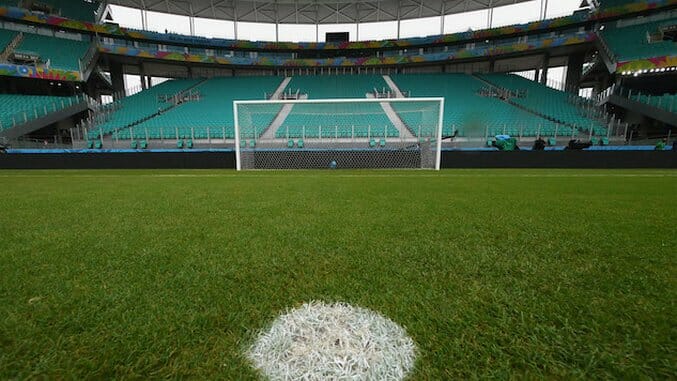Brazil’s Fonte Nova Stadium a Bright Light Ahead of Olympic Soccer at Rio 2016
Photo by Dean Mouhtaropoulos/Getty
The state of Bahia is considered by many to be the heart of Brazil. The region is roughly the same size as France, is known as the home of afro-brasileiro culture, and hosts some of the best sporting events in the country. In Bahia, soccer loyalties run deep, but unfortunately financial mismanagement runs deeper.
Two years after the World Cup, few can deny the grandeur of Itaipava Arena Fonte Nova, Salvador’s premier futebol stadium, but many question its practicality. The city hosts the state’s two biggest clubs, EC Vitória and EC Bahia, yet the former returned almost immediately to its original stadium, and many anticipate the same for the latter.
The Fonte Nova seats 55,000, hosted several World Cup matches, and will be used again for the 2016 Summer Olympics. It has a turbulent history; the existing stadium replaced the original 1951 Estádo Fonte Nova after a roof collapse in 2007, which killed seven and injured many more. While tragic and well-documented, the lesser known legacy of the Fonte Nova is the social impact of the luxurious new venue, which still resonates today and is due to reignite with the 2016 Olympics around the corner.

The original ‘07 proposal for the new stadium envisioned benefits beyond the World Cup, and construction companies claimed it would create lots of new jobs. More than 10,000 professionals were involved in tearing down the old stadium and building the new one. During live events, the stadium employs roughly 3,000 people. Local student and proud Bahia fan Helder Santos de Jesus, 28, has been to both stadiums and thoroughly enjoys the new one. “There are more drinks, better seats, and the whole thing is more beautiful”, he says, claiming that interest in attending matches has risen since completing the new Fonte Nova.
De Jesus represents a small, younger generation of Bahians, who plan to pursue a university education and can afford to pay for entertainment. He was proud to show me his chemistry textbook during our conversation, sharing his plans to become a pharmacist in order to leave his job as a technician at TV subscription company SKY Brasil. He and his friends regularly attend matches whenever Bahia is playing.
I went to see whether the new Fonte Nova is as wonderful as de Jesus’s claims. You didn’t need the stadium’s address to find it; the drumming and cheering of fans can usually be heard long before the stadium is in sight, and the incessant percussion rises and falls with the heightening and loosening of tensions during the match. The crowd ambience speaks for itself; there is only one 100 square meter screen in the stadium, and it only shows in-game substitutions—there are no updates on other matches or statistics for any player, and there are hardly any ads. The horseshoe seat layout also includes a large window at the south end that has a broad view of the adjacent lake, which allows diehard fans to gather on the opposite end for drumming and dancing behind the goal.
Though it suits the native Brazilian crowd well, the design process was outsourced to the German architecture firm Schulitz Architekten. Lead architect Claas Schulitz explained that his team strived to capture the quintessential Brazilian experience by visiting many other existing stadiums, working hard “to keep Brazilian stadium tradition alive and not design a ‘European’ standard stadium.” While constricted by international requirements for World Cup ready stadia, Schulitz felt that had accomplished their stated goal.
Others confirm the success of Schulitz’s vision, and the positive effect the Fonte Nova has had on the surrounding community. Local business owner Fredy Santos de Azevedo appreciated what the stadium did for public transport — when asked why he claimed to like the Fonte Nova, he immediately responded “mobility!”.

De Azevedo says there are now many direct routes to the stadium through the dense surrounding neighborhoods, and developing them the network of mediocre transport through Nazaré, Pelourinho, and Tororó, had finally been acknowledged by the government. He also appreciated the waterproof roof that covers every available seat, noting “in a tropical climate like this, it’s a surprise when stadiums don’t include a roof”. That same roof also recycles rainwater, one among many sustainable features which can be found listed here.
-

-

-

-

-

-

-

-

-

-

-

-

-

-

-

-

-

-

-

-

-

-

-

-

-

-

-

-

-

-

-

-

-

-

-

-

-

-

-

-









































